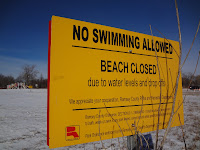Although not as bad as other parts of the world, the Midwest still stuffers from water depletion. The Ogalla aquifer is located partially in the Midwest, spanning eight states.
This aquifer (the shaded reason) is in danger of being completely depleted in only a few decades if we keep using the same amount of water that we have been. It is even a possibility that it could be depleted faster than that if we increase our water usage, which is definitely plausible. The Ogalla aquifer provides nearly all the water for residential, industrial, and agricultural use. Irrigated agriculture provides the base of the economy for the region and it also accounts for 94% of the groundwater use. This region’s agriculture is a vital contributor to nearly one fifth of wheat, corn, and cattle produced in the United States. These provide food for animals that then support industries such as the meatpacking industry. If the Ogalla aquifer became completely depleted it would deeply affect the population and economic activity of the region.
Now let’s take a look at the effects of water depletion closer to home.
These pictures are taken from the Ramsey County Beach near my home. I remember when the water was about 10 feet from the lifeguard’s stand. Now, you can’t even see the water line in this first picture. The second picture shows that the beach has been closed due to the low water levels and drop offs. During the summer the water is so shallow for such a long distance, it is impossible to swim at this beach. Only a few years ago the water levels were much higher. In the third picture, you can see a dock that barely reaches the water line; much of it is in weeds and what used to be underwater.
Sources:
Sources:
"Ogallala Aquifer." Water Encyclopedia. Web. 23 Feb. 2012. <http://www.waterencyclopedia.com/Oc-Po/Ogallala-Aquifer.html>.
Peterson, Jeffrey M., Thomas L. Marsh, and Jeffery R. Williams. "Conserving the Ogallala Aquifer: Efficiency, Equity, and Moral Motives." Choices Magazine. Feb. 2003. Web. 23 Feb. 2012. <http://www.choicesmagazine.org/2003-1/2003-1-04.htm>.




